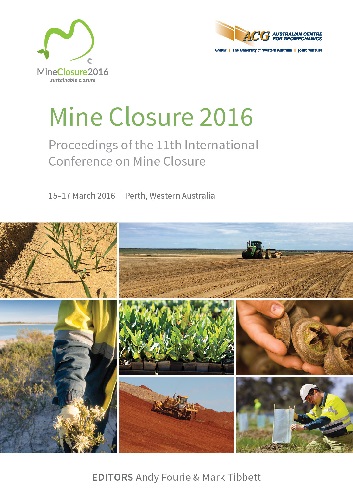In situ bioremediation of South African coal discard dumps

|
Authors: Cowan, AK; Lodewijks, HM; Sekhohola, LM; Edeki, OG |
DOI https://doi.org/10.36487/ACG_rep/1608_37_Cowan
Cite As:
Cowan, AK, Lodewijks, HM, Sekhohola, LM & Edeki, OG 2016, 'In situ bioremediation of South African coal discard dumps ', in AB Fourie & M Tibbett (eds), Mine Closure 2016: Proceedings of the 11th International Conference on Mine Closure, Australian Centre for Geomechanics, Perth, pp. 507-515, https://doi.org/10.36487/ACG_rep/1608_37_Cowan
Abstract:
Current rehabilitation of coal discard dumps remains a challenge due to reliance on topsoil for establishment of vegetation. Fungcoal has been developed as a viable and alternative strategy for rehabilitation of coal discard dumps and opencast spoils. Fungcoal exploits fungi-plant mutualism to achieve biodegradation of weathered coal, which in turn, promotes reinvigoration of soil components, grass growth and re-vegetation. The main objective of the present study was to determine the effect of different co-substrate materials as carbon donor to support Fungcoal-induced humic acid-like substance enrichment of coal discard at commercial scale. This was achieved by monitoring changes in physicochemical properties of the substrate after Fungcoal application over a three-year period. Results show that where Fungcoal was applied with weathered coal as the carbon donor, and in the absence of added topsoil, it suppressed acidification and salinisation of the coal discard substrate and promoted humic acid-like substance enrichment to support growth and establishment of annual and perennial grasses. In the absence of co substrate or where highly oxidised coal discard was used as co-substrate, no humic acid-like substance enrichment of the substrate was observed, substrate pH declined, cation exchange capacity and electrical conductivity remained elevated, and re-vegetation failed. The potential of an in situ bioremediation strategy like Fungcoal as an alternative to topsoil is discussed.
References:
Igbinigie, EE, Mutambanengwe, CZ & Rose, PD 2010, ‘Phyto-bioconversion of hard coal in the Cyanodon dactylon/coal rhizosphere’, Biotechnology Journal, vol. 5, no. 5, pp. 292–303.
Igbinigie, EE, Aktins, S, Van Breugel, Y, Van Dyke, S, Davies-Coleman, MT & Rose, PD 2008, ‘Fungal biodegradation of hard coal by a newly reported isolate, Neosartorya fischeri’, Biotechnology Journal, vol. 3, no. 11, pp. 1407–1416.
Janos, P 2003, ‘Separation methods in the chemistry of humic substances’, Journal of Chromatography A, vol. 983, pp. 1–18.
Juwarkar, AA & Jambhulkar, HP 2008, ‘Phytoremediation of coal mine spoil dump through integrated biotechnology approach’, Bioresource Technology, vol. 99, no. 11, pp. 4732–4741.
Juwarkar, AA, Yadav, SK, Thawale, PR, Kumar, P, Singh, SK & Chakrabarti, T 2009, ‘Developmental strategies for sustainable ecosystem on mine spoil dumps: a case study’, Environmental Monitoring and Assessment, vol. 157, no. 1–4, pp. 471–481.
Kidd, PS & Proctor, J 2001, ‘Why plants grow poorly on very acid soils: are ecologists missing the obvious?’, Journal of Experimental Botany, vol. 52, no. 357, pp. 791–799.
Klein, OI, Kulikova, NA, Konstantinov, AI, Fedorova, TV, Landesman, EO & Koroleva, OV 2013, ‘Transformation of humic substastances of highly oxidized brown coal by Basidiomycetes Trametes hirsute and Trametes maxima’, Applied Biochemistry and Microbiology, vol. 49, no. 3, pp. 287–295.
Laborda, F, Monistrol, IF, Luna, N & Fernandez, M 1999, ‘Processes of liquefaction/solubilization of Spanish coals by microorganisms’, Applied Microbiology and Biotechnology, vol. 52, no. 1, pp. 49–56.
Limpitlaw, D & Briel, A 2015, ‘Post-mining land use opportunities in developing countries–a review’, The Journal of The Southern African Institute of Mining and Metallurgy, vol. 114, pp. 1–5.
Limpitlaw, D, Aken, M, Lodewijks, H & Viljoen, J 2005, ‘Post mining rehabilitation, land use and pollution at collieries in South Africa’, in Proceedings of the colloquium: sustainable development in the life of coal mining, The Southern African Institute of Mining and Metallurgy, vol. 1, pp. 1–10.
Maiti, KS 2007, ‘Bioreclamation of coalmine overburden dumps with special emphasis on micronutrients and heavy metals accumulation in tree species’, Environmental Monitoring and Assessment, vol. 125, no. 1–3, pp. 111–122.
Mukasa-Mugerwa, TT, Dames, JF & Rose, PD 2010, ‘The role of a plant/fungal consortium in the degradation of bituminous hard coal’, Biodegradation, vol. 1, pp. 1–13.
Rayment, GE & Higginson, FR 1992, Australian Laboratory Handbook of Soil and Water Chemical Methods, Inkata Press, Melbourne.
Rose, PD, Igbinigie, EE, Horan, MP, Dames, JF & Mukasa-Mugerwa, TT 2010, ‘Beneficiation of coal’, South African Patent Office, ZA 2010/02354.
Ross, DS 1995, ‘Recommended Methods for Determining Soil Cation Exchange Capacity’, in JT Sims & A Wolf (eds) Recommended Soil Testing Procedures for the Northeastern United States, 2nd edition, University of Delaware Press, Newark DE.
Ross, DS & Ketterings, Q 2011, ‘Recommended Methods for Determining Soil Cation Exchange Capacity’, in A Wolf and J McGrath (eds), Recommended Soil Testing Procedures for the Northeastern United States, 3rd edition, Northeastern Regional Publication No. 493,
Salt, DE, Smith, RD & Raskin, I 1998, ‘Phytoremediation’, Annual Review of Plant Physiology and Plant Molecular Biology, vol. 49, pp. 643–668.
Sekhohola, LM, Igbinigie, EE & Cowan, AK 2013, ‘Biological degradation and solubilisation of coal’, Biodegradation, vol. 24, no. 3, pp. 305–318.
Sekhohola, LM, Isaacs, ML & Cowan, AK 2014, ‘Fungal colonization and enzyme-mediated metabolism of waste coal by Neosartorya fischeri strain ECCN 84’, Bioscience, Biotechnology and Biochemistry, vol. 78, no. 10, pp. 1797–1802.
Sourkova, M, Frouz, J & Santruckova, H 2005, ‘Accumulation of carbon, nitrogen and phosphorus during soil formation on alder spoil heaps after brown-coal mining, near Sokolov (Czech Republic)’, Geoderma, vol. 124, no. 1–2, pp. 203–214.
Zu, C, Li, Z, Yang, J, Yu, H, Sun, Y, Tang, H, Yost, R & Wu, H 2014, ‘Acid soil is associated with reduced yield, root growth and nutrient uptake in black pepper (Piper nigrum L.)’, Agricultural Sciences, vol. 5, pp. 466–473.
© Copyright 2025, Australian Centre for Geomechanics (ACG), The University of Western Australia. All rights reserved.
View copyright/legal information
Please direct any queries or error reports to repository-acg@uwa.edu.au
View copyright/legal information
Please direct any queries or error reports to repository-acg@uwa.edu.au